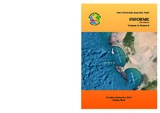Por favor, use este identificador para citar o enlazar este ítem:
https://hdl.handle.net/20.500.12958/2993Registro completo de metadatos
| Campo DC | Valor | Lengua/Idioma |
|---|---|---|
| dc.contributor.author | Argüelles Torres, Juan | - |
| dc.contributor.author | Taipe Yzarra, Anatolio | - |
| dc.contributor.author | Sanjinez Alvites, Maria Nelly | - |
| dc.contributor.author | Espinoza López, Ericka | - |
| dc.date.accessioned | 2016-03-29T17:30:57Z | - |
| dc.date.available | 2016-03-29T17:30:57Z | - |
| dc.date.issued | 2015 | - |
| dc.identifier.citation | Inf Inst Mar Perú 42(4), 2015. p. 460-473 | es_ES |
| dc.identifier.uri | https://hdl.handle.net/20.500.12958/2993 | - |
| dc.description | Informe IMARPE;Vol. 42, N° 4, 2015 p.460-473 | es_ES |
| dc.description.abstract | En los alrededores de la isla San Lorenzo, en el 2014, bimensualmente se efectuaron muestreos en siete estaciones, monitoreando a los bivalvos Argopecten purpuratus, Glycymeris ovata y los crustáceos Romaleon polyodon, Cancer coronatus, Cancer porteri y Hepatus chilensis; también, se efectuaron experimentos de marcación y recaptura para determinar tasas de crecimiento en A. purpuratus, G. ovata, Semele spp., Gari solida y Protothaca thaca. A. purpuratus fue más abundante a finales del año, periodo en el que (como en el 2013) se registraron mayores valores de oxígeno a nivel de fondo del mar. R. polyodon presentó tendencia creciente de la talla media y biomasa. C. coronatus fue observado frecuentemente al norte de la isla San Lorenzo con densidades máximas de 10,67 ejemplares.10min. El cangrejo Platymera gaudichaudii fue observado solo en diciembre con densidades medias de 24 ejemplares.10 min de buceo. Se marcaron 7214 ejemplares y recapturaron 2730 ejemplares. G. ovata tuvo el 80% de recaptura y A. purpuratus 24%. Las tasas de crecimiento presentaron tendencias decrecientes a mayores tallas en todas las especies. En G. ovata la tasa de crecimiento fue mayor en ejemplares liberados en La Pampa diferente al comportamiento en Cabinzas; también se observaron diferencias entre las almejas Semele spp. y Gari solida. La abundancia de G. ovata en mayo y setiembre fue de hasta 190 ejemplares y 648,6 g por m². Las mayores densidades se registraron al noroeste de la isla San Lorenzo, mayor incidencia de esta especie estuvo en el substrato formado por conchuela molida. El rendimiento de G. ovata fue mayor en el área La Pampa respecto a Cabinzas, Palomino y Mal Nombre. | es_ES |
| dc.description.abstract | ABSTRACT: The main results of the monitoring of marine invertebrates in seven stations along the east side of the San Lorenzo Island, Callao; tagging of marine invertebrates, and monitoring of Glycimeris ovata around the islands off Callao are presented in this report. The monitoring were carried out each two month and the species monitored were the bivalves Argopecten purpuratus, Glycymeris ovata; and the crustaceans Romaleon polyodon, Cancer coronatus, Cancer porteri and Hepatus chilensis. The tagged species were A. purpuratus, G. ovata, Semele spp., Gari solida and Protothaca thaca. A. purpuratus showed higher abundances at the end of the sampling period, months in which higher oxygen levels was recorded. The crab R. polyodon presented an increasing trend in mean size and biomass during the sampling period. Among the other sampled crabs, C. coronatus was more frequently observed during the year mainly at the north of the San Lorenzo Island with maximum densities of 10.67 individuals.10min-1. Platymera gaudichaudii was observed only during December with densities of 24 individuals.10min-1 driving. 7214 individuals were tagged and 2730 individuals were recaptured. G. ovata showed the highest values of recapture (80%) followed by A. purpuratus (24%). Growth rates showed decreasing trends to larger sizes in all species. In G. ovata growth rates were higher in individuals tagged and released in the La Pampa area regarding individuals tagged and recaptured in Cabinzas area. Also, differences in growth rates between Semele spp. and Gari solida were observed. The abundance of G. ovata showed maximum values of 190 individuals and 648.6 g per m² during May and September. The highest densities were recorded at the northwest of the San Lorenzo Island, and were most frequently observed in the substrate composed by milled shell. The yield of G. ovata was higher in the Pampa area regarding to the other three areas (Cabinzas, Palomino and Mal Nombre) | - |
| dc.description.sponsorship | Instituto del Mar del Perú | es_ES |
| dc.language.iso | spa | es_ES |
| dc.publisher | Callao | es_ES |
| dc.relation.ispartofseries | Informe IMARPE;Vol. 42, N° 4, 2015 | - |
| dc.rights | info:eu-repo/semantics/openAccess | es_ES |
| dc.rights.uri | https://creativecommons.org/licenses/by/4.0/ | - |
| dc.source | Instituto del Mar del Perú - IMARPE | es_ES |
| dc.source.uri | Repositorio Digital IMARPE | es_ES |
| dc.subject | Invertebrados Marinos | es_ES |
| dc.subject | Distribución | es_ES |
| dc.subject | Monitoreo | es_ES |
| dc.subject | Bivalvos | es_ES |
| dc.subject | Crustáceos | es_ES |
| dc.title | Monitoreo y marcación de invertebrados marinos, Callao, Perú, 2014 | es_ES |
| dc.title.alternative | Monitoring and tagging of marine invertebrates in Callao, Peru, 2014 | es_ES |
| dc.type | info:eu-repo/semantics/article | es_ES |
| Aparece en las colecciones: | Informe vol. 42(4) 2015 | |
Ficheros en este ítem:
| Fichero | Descripción | Tamaño | Formato | |
|---|---|---|---|---|
| Informe 42(4)-3.pdf | 3,18 MB | Adobe PDF |  Visualizar/Abrir |
Este ítem está sujeto a una licencia Creative Commons Licencia Creative Commons

